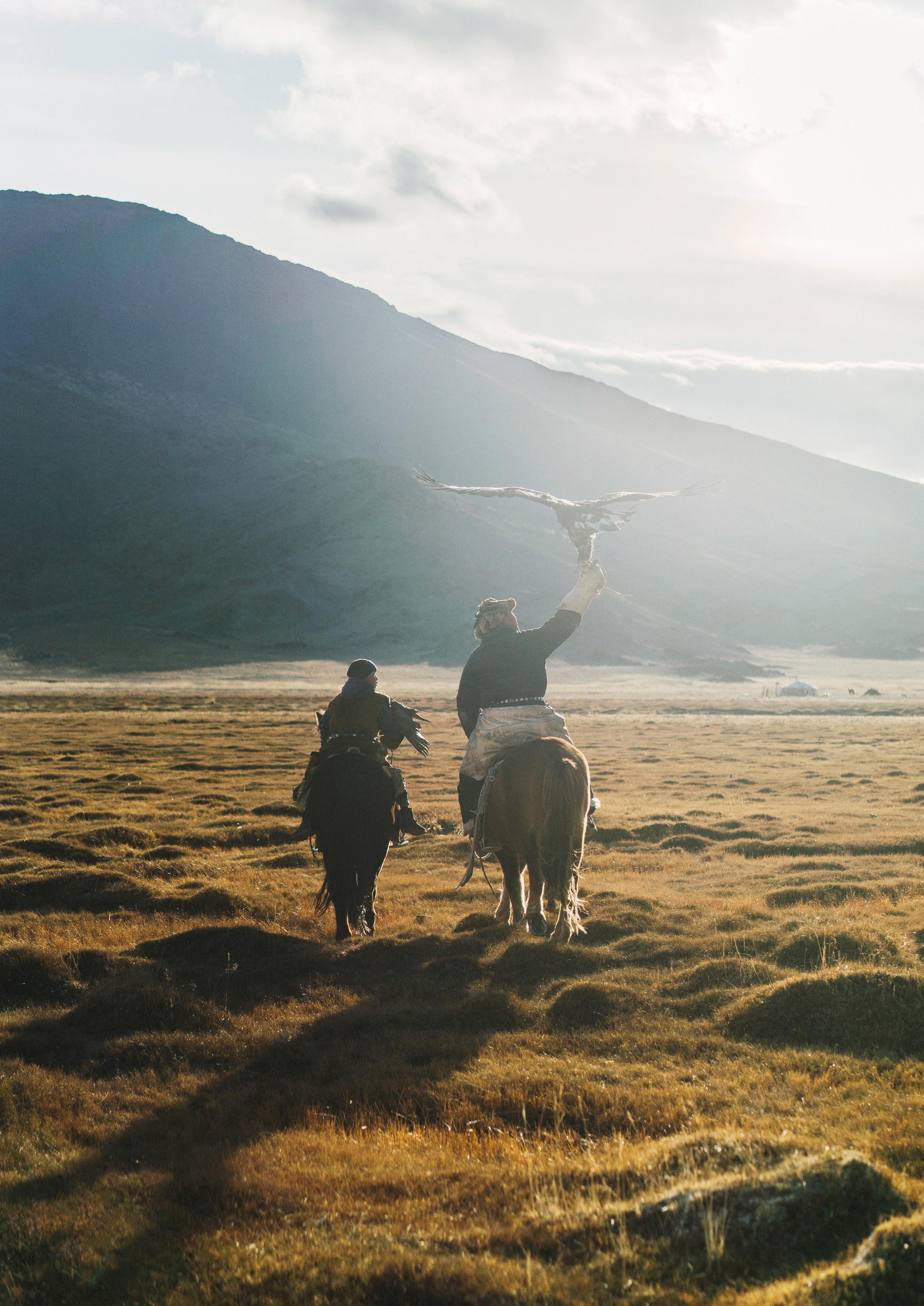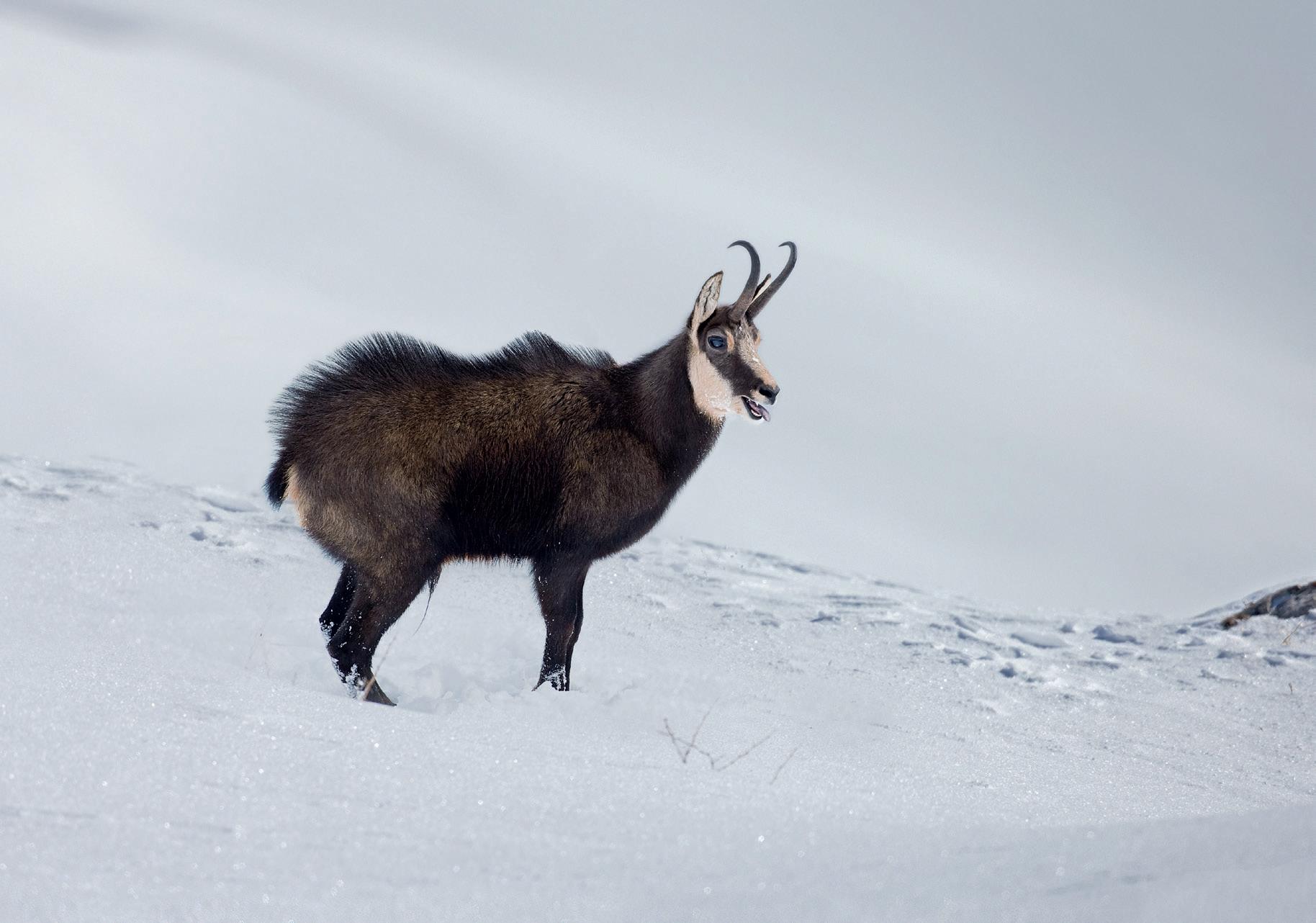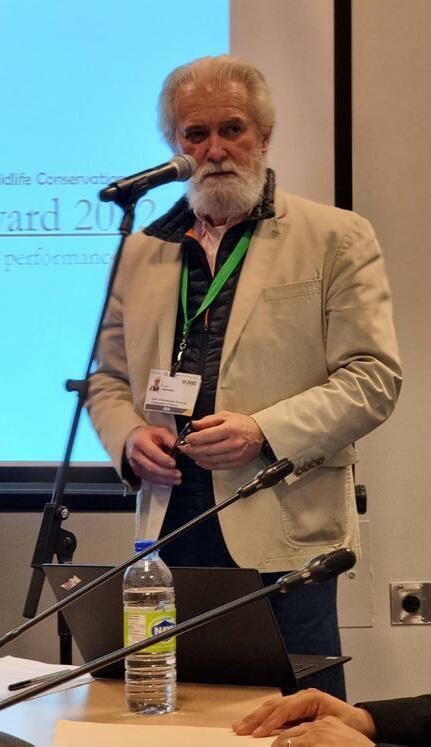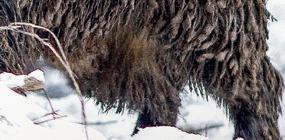




 CIC Administrative Office:
CIC Administrative Office:







 CIC Administrative Office:
CIC Administrative Office:

2022 was most certainly a busy year for the CIC. As always, we worked to highlight the importance of hunting as a conservation tool, while shining a light on the services that hunters render to nature and society.
With the possibility of international travel very much possible, we were able to spread our message at numerous international events, conferences and more, much like we have done in years past.
Perhaps the most impactful event for the organisation was the successful change in leadership at the CIC Administrative Office.
In November, Tamás Marghescu stepped down from the position of Director General after twelve successful years in the position. I extend my personal thanks to Tamás for his years of hard work, and for his selfless support during the transition process.
The CIC’s leadership team now consists of Sebastian Winkler and Arno Wimpffen as the new Director General and Deputy Director General respectively.
Under their guidance, I am positive that we can bring some new and exciting ideas to the CIC and its work in supporting global biodiversity. We have already seen how they can positively influence the CIC in their new roles, namely through their participation and input at two recent international conferences; the CITES CoP19 and the CBD COP15.

For an overview of these events, as well as all of our other notable activities in the last six months, I welcome you to look through this wonderful winter edition of the CIC Magazine.
Wishing you all festive holidays and a happy new year,
Dr. Philipp Harmer President of the
CIC


The Convention on Biological Diversity (CBD) has adopted a decision recognising the value of sustainable use in implementing the UN Sustainable Development Goals (SDGs) and the post 2020 global biodiversity framework. The news came as part of the Fifteenth Meeting of the Conference of the Parties to the CBD (CBD COP15) in Montreal, Canada.
CBD COP15 was a landmark event, with the foremost thinkers and practitioners working on biodiversity matters gathering to decide on the future of global conservation. Most notably, the post 2020 global biodiversity framework was adopted at the event, shaping the future of conservation activities for the coming years.
As part of the conference proceedings, a decision was adopted by the CBD which inter alia recognised sustainable use – including the management of wildlife – as a tool that has contributed towards progress in the SDGs, the Aichi Biodiversity Targets while remaining relevant for the aforementioned global biodiversity framework. The Collaborative Partnership on Sustainable Wildlife Management (CPW) - a partnership of 14 international organisations including the CIC, which was a founding member – made a joint statement at CBD COP15 welcoming the decision.
In particular, the statement emphasised the importance of the decision in relation to continuing the work on sustainable wildlife
RECOGNISES THE VALUE OF
management that can significantly contribute to biodiversity conservation.
The CPW is a voluntary partnership consisting of organisations with mandates to promote the sustainable use and conservation of wildlife resources.
hunting, as well as partnership coordination and outreach.
Now that this decision has been adopted, this sets a new path for better coordination between CPW members and the CBD.
In this regard, the CIC echoes the sentiments of the CPW joint statement, which highlights a willingness to continue working on relevant wildlife related topics going forward.
“We are preparing to meet the new sustainable wildlife management challenges that lie ahead, with the adoption of a new set of CPW thematic objectives.
Together, we bring rich expertise and technical knowledge that will directly contribute to the implementation of both the Decision on sustainable wildlife management and also the ambitious targets of the global biodiversity framework.”
Each CPW member carries out work and programs relating to different aspects of sustainable use; through this multi-faceted approach, they are able to target a variety of thematic areas that can holistically address the SDGs and the global biodiversity framework.
Among the work areas currently being addressed within the CPW is food security, livelihoods, human-wildlife conflict, illegal and unsustainable
Highlighting the contributions of the CPW within the CBD was a COP15 side-event, which explored the role of sustainable management of wild species by Indigenous Peoples and Local Communities in meeting the global biodiversity framework.

A progress report on the activities of the CPW since 2019 can be found on the CBD website.

The CIC is delighted to announce that the 2022 CIC Markhor Award has been presented to a project on Repatriating Desert Bighorn Sheep, which saw freerange desert bighorn sheep numbers grow from 0 to 1,500 across three Mexican states.


The Markhor Award is hosted at every CBD COP and is awarded to projects that link the conservation of biodiversity and human livelihoods through sustainable use. At this year’s CBD COP15 in Montreal, Canada the award was presented to the winners by Dr. Dilys Roe (Chair of the IUCN Sustainable Use and Livelihoods Specialist Group), who was on stage at the ceremony alongside Arno Wimpffen (CIC Deputy Director General), and Shane Mahoney (Head of the CIC Policy and Law Division).
After a thorough evaluation of all nominees, the project in Mexico stood out to the CIC jury for its innovative use of nursery herds to

repatriate desert bighorn sheep. This is a practice that is already conducted in North America, which was applied and adapted to the host country to restore one of their historic species.
The use of nursery herds involves trapping and translocating desert bighorn sheep from areas where they are well populated to new areas
with little - or in this case no - individuals of the species. Through this method, a starting population of 353 desert sheep grew to 1,500 in the space of a few years in three ranches located around Mexico.
Nominated by the Wild Sheep Foundation (WSF), the award goes to the following individuals for leading the project in their respective states:
• Javier Arteé (Sonora, Rancho Sierra El Álamo)
• Emilio Rangel Woodard (Coahuila, Rancho La Palmosa)
• Jose Antonio Vallina (Chihuahua, Rancho La Guarida)
amongst landowners and outfitters. The aim of the Counsel was to promote the enhancement, conservation, and repatriation of desert bighorn sheep using market forces and sustainable use (including hunting) as a guiding principle.
The sustainable utilisation of a few select individuals - once a healthy population has been established - incentivises a broader adoption of this model, as it allows these types of operations to be self-sustaining given the high start-up cost that is required.
The CIC congratulates the award winners for their wonderful achievement, and welcomes others to follow their example in implementing and adapting conservation best practices to new regions around the world.


The award winners are all members and leaders of WSF’s Mexico Counsel, which was established in 2017/18 to promote cooperation


The Flying Vets Project in Mongolia has secured $2 million in funding, following a successful application to UNEP’s Nature for Health (N4H) initiative.

The CIC is one of the agencies implementing the Flying Vets Project, which looks to strengthen Mongolia’s ability to implement a One Health approach in dealing with wildlife diseases, including zoonoses.
The N4H initiative is run by the United Nations Environment Programme (UNEP), and was created to reduce the risk of future pandemics and by fostering locally developed, integrated
approaches to secure the health of people, animals and the environment. Supported by the Government of Germany, the initiative brings together leading UN agencies, Intergovernmental Organisations and civil society groups.
The Flying Vets application was submitted to UNEP earlier this year following a series of workshops on the project in Mongolia. Three Mongolian Ministers provided endorsements in support of the application; the Ministry of Food, Agriculture and Light Industries (MoFALI), the Ministry of Health (MoH), and the Ministry of Environment and Tourism (MOET).
With this funding secured, the project is planned to go ahead with a conventional UN based approach to running an in-country project, while being complimented by cutting edge initiatives which make a difference on the ground.
The road ahead will be focused on developing four core working areas identified as part of the workshops. Each working area will look to strengthen gaps within Mongolia’s wildlife

The Flying Vets was launched in April, 2021. It was born out of Flurina Hammer’s (CIC Member and Flying Vets Board Member) participation in the 2022 Mongol Derby, and her desire to contribute towards the CIC’s work in supporting wildlife and human well-being.

With the Derby serving as an international platform to raise awareness and funding for the project - with Flurina finishing 12th in the racethe Flying Vets has come a long way in the past six months.
Two workshops have been held in Ulaanbaatar, Mongolia, bringing together the animal, human and environmental sectors to explore the current state of disease monitoring and management in the country.

Among the outcomes of the workshops was the identification of gaps in the country’s wildlife disease surveillance measures, the actions needed to promote inter-sectoral collaboration, as well as the steps required to address any issues of note.


November 3rd was One Health Day, an international campaign that brings attention to the need for a One Health trans-disciplinary approach towards solving critical global health challenges. Our encroachment into wild and natural spaces is an issue that grows with every passing second. Wildlife is an entangled part of human existence, and the threat of infectious wildlife diseases is one that has to be addressed now rather than later.
The COVID-19 pandemic serves as a stark reminder of the potential consequences of inaction.
With that in mind, what are the potential solutions to these issues?
As part of One Health Day, FAO and the EcoHealth Alliance published a study which suggests that the integration of the natural resource sector into efforts to mitigate the risk of emerging infectious diseases is essential.
The Flying Vets projects is one real world example of this idea in practice.
The Flying Vets is an initiative of the CIC and the World Organization for Animal Health (WOAH), which looks to strengthen Mongolia’s ability to implement a One Health approach in dealing with wildlife diseases, including zoonoses.
By bringing together stakeholders from the environment, human health and veterinary sectors, we can work on solutions to critical issues such as wildlife disease surveillance in a more effective and timely manner.
Supporting The Flying Vets – and other projects that bridge the gap between different disciplines to solve global health issues – will be essential if we are to build towards a sustainable future. For more information on The Flying Vets, visit our dedicated webpage on the project.

Several nations have recently committed to the future of migratory waterbird conservation at the world’s biggest international conference on this topic.
The Eighth Session of the Meeting of the Parties to the African-Eurasian Migratory Waterbird Agreement (AEWA MOP8) was hosted in Budapest, Hungary on 27-30 September, 2022.
AEWA is an intergovernmental treatyadministered by the United Nations - dedicated to the conservation of migratory waterbirds and their habitats across Africa, Europe, the Middle East, Central Asia, Greenland and the Canadian Archipelago.
AEWA hosts their MOP to give an opportunity for governments to overview bird conservation activities around the world while exploring possible actions for the future.
The AEWA meeting was among the largest conferences focusing on migratory waterbird conservation in recent history. Over 200 people were in attendance, representing 45 different countries within the deliberations.
AEWA MOP8 was invited to take place in Budapest by the host country government. The Deputy Prime Minister of Hungary, Dr Zsolt Semjén, was among the speakers at the opening ceremony to welcome participants to the event. This meeting came at a particularly critical time, as new reports suggest that half of bird species are currently in decline. A further eighth of species are at threat of going extinct.
Over the course of AEWA MOP8, 16 resolutions and new guidelines were agreed upon by the parties in attendance, helping to secure the future of many of the 255 species covered under AEWA.
To give an example, one outcome of the event was the introduction of a new international action plan for the Common Eider, a sea-duck species which is currently in decline. It is hoped that these new measures will help recover populations in the numerous areas where this species can be found.

As keen supporters of migratory waterbirds and their conservation, the CIC and Delegations of the CIC were proud to be sponsors of the event. Hunters are one of the few stakeholders with a vested interest in the health of waterbird populations, and the CIC remains dedicated to building cooperation within the hunting community for the benefit of their conservation.
Dallas Safari Club (DSC), Leica Camera AG and RAUCH were among the other sponsors of the AEWA MOP8.











The CIC joined in celebrating World Migratory Bird Day (WMBD) on October 8th.
WMBD is a bi-annual event hosted by AEWA – the Agreement on the Conservation of African-Eurasian Migratory Waterbirds – which looks to raise awareness on the importance of migratory waterbirds and the cooperation required to conserve them.

As part of this year’s theme, WMBD brought attention to the impact of light pollution on migratory birds.
In support of this theme, we challenged our friends and members to reduce the amount of light they produce when visiting coastal areas during May’s celebration of WMBD.

Since then, we have heard several accounts of people looking to mitigate their impact on birds by limiting the amount of light they produce when going on hunts. We extend our thanks to everyone that got involved!

As one of the few stakeholders with a vested interest in migratory waterbirds, the CIC understands the value in getting hunters engaged in their continued survival.
To continue raising awareness on this vital topic, we are encouraging you to view this animation produced for WMBD 2022.


Follow a small songbird as it is lured into the dangers of the city by intense lights. The threats it faces are common for migrating birds trying to navigate urban environments. By turning out nonessential lighting at night, birds are less likely to become disoriented on their long journeys.

After two weeks of deliberations at CITES CoP19, it can be argued that we have been left with more questions than answers on international wildlife trade and the Convention itself.
Going into the CoP, many felt that the discussions in Panama would play a critical role in determining the long-term future of livelihoods and wildlife conservation across the globe. Reflecting on the outcomes at its conclusion, the resolutions and recommendations can be described as a mixed bag when compared to many people’s ambitions prior to the event.
Indigenous people and local communities (IPLCs) were most certainly amongst the stand out issues throughout the course of the meeting. For more in-depth coverage of the events that took place pertaining to IPLCs, please see our report dedicated to this topic.
The message from the high-level government representatives, community leaders and NGOs speaking on IPLCs was clear: 1) IPLCs should be included in CITES’ decision-making, 2) More should be done to recognise their contributions to conservation and the link between wildlife and livelihoods.

It was therefore disappointing to see a lack of progress being made on a number of primary IPLC issues of note.
The lack of progress was highlighted by the outcomes of two specific agenda items which were heavily promoted throughout the course of CoP19. This was the proposal to create a Rural Communities committee (Item 15) to help amplify rural voices, and the proposal to take livelihoods into consideration when listing species into CITES Appendices (Item 87.1), both of which were unfortunately not adopted.
Inaction from CITES on these issues, however, should be attributed to the structure of the Convention itself, rather than the absence of good intention.
With 184 Parties to the Convention, interests will rarely be aligned between all nations involved in the voting process.
This in part explains the slow-moving nature of decision-making in CITES, with actions being determined by wider consensus rather than importance.
There is no immediate solution to this problem at this moment in time. In the short-term future, focusing on advocacy work seems like the best and only way for IPLCs to voice their concerns to a wider international audience.
As a consolation, there were some successes that were seen throughout the proceedings, including the rejection of a proposal to shift the African elephant to Appendix I in a number of countries (Item 89).
An intersessional working group on IPLCs was also renewed, which will look to explore issues such as IPLC engagement and participatory mechanisms for rural communities in CITES (Items 13 & 15). It is worthwhile noting, however, that the proposal from the secretariat to engage IPLCs in CITES processes at the international level was not accepted.
While significant in their own right, it should be made clear that these successes are minor when compared to the marco-level concerns of CITES as an institution.
With an eye to the future, perhaps the most interesting turn of events was the decision for CITES to adopt a One Health approach in its work (Item 15), which will help reduce the risk of future zoonotic disease emergence associated with wildlife trade.
A working group dedicated to this topic was created as part of the proceedings, which the CIC made the decision to join.
One Health is a major part of the new CIC Statutes, and the organisation’s commitment to working on sustainable development issues.
It is hoped that the CIC will be able to assist CITES in this working group and its efforts to strengthen economic and wildlife resilience through increased trans-boundary cooperation – the principal aim of One Health.
A full list of the CIC’s position statements on the agenda items of note can be read here.
A summary of all decisions made at CITES CoP19 can be found here.


“The Impact of CITES Decision-Making on Livelihoods and the Role of IPLCs in the Convention.”CIC Director General, Sebastian Winkler, and CIC Policy Coordinator, Alexandra Kalandarishvili (Photo by IISD/ENB)

Indigenous peoples and local communities (IPLCs) will be playing a bigger role in conservation decisions following the adoption of the Kigali Call to Action for People and Nature by the over 2,400 delegates in attendance at IUCN APAC 2022, among whom were representatives of government and civil society.
As an official co-sponsor, the CIC helped to ensure a strong participation of IPLCs at the event, which far too often are not heard in such international policy processes.
The inaugural IUCN APAC was a landmark event on the future of conservation in Africa, with Congress participants assessing the current role of African protected areas for development and conservation. In attendance were governments, African regional bodies, NGOs, national and international experts and organisations, academia, the private sector and more.
Among the recommendations mentioned in the Kigali Call to Action were some long awaited recognitions of IPLCs, specifically calls for their knowledge and practices to be included in conservation actions, better recognition of their rights, and mechanisms for their voices to be heard.
When discussing the inclusion of IPLCs in conservation activities going forward, governments, civil society and private actors were among the stakeholders that were referenced, thereby calling upon international bodies such as the IUCN, CITES and CBD to take greater account of IPLCs in their decisions and policy-making.
As a supporter of conservation through sustainable use, the CIC is well aware that the best examples of successful conservation come from countries that use regulated hunting – in
conjunction with IPLC knowledge and actions –as part of their conservation strategy. A number of key figures in the world of conservation spoke on the deliberations that took place in Kigali, as well as their implications for the future of environmental decision-making.
Dr. Dilys Roe, Chair of the IUCN Sustainable Use and Income Generation Expert Group (SULi), highlighted the role that sustainable use had in the discussions at APAC.

“At APAC, it was clear that sustainable use will play a key role in the management of protected areas in Africa. Photo tourism and hunting already provide the lion’s share of their funding and will continue to do so in the future.”
Providing a perspective from the local community side was Zambian conservationist Bupe Banda, representing the Community Leaders Network (CLN), a coalition of local communities from nine South African states.

“I hope that the outcome of APAC will influence both bodies, CITES and CBD. Both are currently making decisions without Africa’s voices.”
Going forward, the CIC encourages all stakeholders, including international environmental bodies, to take on board the outcomes from the Congress in order to help support wildlife and people throughout Africa, while also increasing the presence and recognition of IP&LCs in the upcoming CITES and CBD meetings in November and December this year.


If you would like to learn more about the Kigali Call to Action for People and Nature, the full statement is available online.
 Dr. Dilys Roe at IUCN APAC 2022 (Credit: Hattingh/CIC)
Bupe Banda at IUCN APAC 2022 (Credit: Hattingh/CIC)
Dr. Dilys Roe at IUCN APAC 2022 (Credit: Hattingh/CIC)
Bupe Banda at IUCN APAC 2022 (Credit: Hattingh/CIC)
The European Federation for Hunting and Conservation (FACE) held its General Assembly on 25-27 October, 2022 in Brussels.

October 25th was a particularly momentous day for FACE, as it marked the 45th anniversary since they were established in 1977.
As a long time partner of the CIC, we extend our sincere congratulations to FACE for remaining committed to working in the interests of European hunters and wildlife during this period of time.
The CIC Director General, Tamás Marghescu (now CIC Ambassador), was in attendance in Brussels to take part in the deliberations, and to present a special gold CIC plaquette to honour FACE on their achievement.
The General Assembly served as an opportunity for the heads of Europe’s hunting associations and organisations to gather and explore the prevailing issues relevant to the wider world of conservation and sustainable use.
FACE’s European Hunters’ Campaign (#SignForHunting) was one of the topics of discussion. Since the campaign was first launched several months ago, FACE have collected some 200,000 signatures towards building a better mechanism for hunting discourse in Brussels. If you have yet to register
your support, you can do so here.
The adoption of the FACE Strategy for 2027 was another significant issue at the General Assembly, with FACE committing to creating a Europe rich in biodiversity and hunting opportunities for the years to come.
The event was rounded off with a discussion in European Parliament on sustainable hunting and conservation best practices, which was hosted by MEP Alex Agius Saliba.
In parallel with FACE’s General Assembly, the CIC delegation in attendance took the time to meet with representatives of the European Commission’s Directorate-Generals for International Partnerships and Environment, where the possibility of forthcoming opportunities for collaboration was explored.
In addition, a visit was paid to the European Forestry House, in which talks were held with the head of EUSTAFOR (European State Forest Association); it is expected that further discussions will take place to elaborate on common interests such as alliances of cooperation.
Once again, the CIC congratulates FACE on 45 wonderful years, and wishes them continued success going forwards.


Calling all hunters and supporters of sustainable use – the CIC invites you to support FACE’s #SignForHunting campaign!

In recent years, Brussels has been the source of numerous problems for hunters and wildlife conservation. In many cases, these issues are often not founded in facts or science.
The #SignForHunting campaign is a call to all hunters wishing for a more balanced approach towards hunting within the EU.
The European-wide initiative provides a platform for hunters to call on EU institutions to work with FACE on the future of hunting and conservation.
The goal? For European biodiversity policies to deliver for nature conservation while recognising the many benefits associated with regulated, sustainable hunting activities.
As a long-standing partner of FACE, the CIC is in full support of this campaign and its efforts to bring biodiversity supporting sustainable use activities back to the table.
How can you support the campaign? Simply go to the official website and register your email address.
The website also contains additional information on the campaign, including a 9-point petition that demands change in key topics related to hunting and conservation.
For a brief overview, we invite you to watch this introductory video on the #SignForHunting campaign.

The CIC joined in celebrating the 10th anniversary of the Ladies Hunting Club in Serbia earlier this year.
The Ladies Hunting Club – or Damski Lovački Klub – works to improve and develop women’s rights through its activities engaging in hunting traditions and culture, as well as biodiversity conservation.
To commemorate the occasion, an event was held on 17 September in Tara National Park, Serbia.

Director General of the CIC, Tamás Marghescu (now CIC Ambassador), was in attendance to honour the organisation, which has been a member of the CIC since 2013.
The celebration was attended by delegations of women hunters’ clubs from Bulgaria, Slovenia, Serbia, Hungary and Croatia.
The presidents of the regional hunting associations of central and western Serbia, representatives of Tara National and local authorities were also present at a gala dinner which took place in the evening.
As part of the evening festivities, the CIC Director General gave a laudatio and presented – on behalf of Dr. Philipp Harmer, President of the CIC – a commemorative plaquette to the President of the Ladies Hunting Club, Sanja Momčilović Bognič.
In his speech, the lady hunters of Serbia were encouraged to take the lead in assisting the CIC in its communications to the public.
The CIC wishes the Lady Hunters Club continued success in the years to come, and welcomes further collaboration with them going forward.

On the agenda of this year’s meeting were a number of prevailing issues, such as the EU Nature Restoration Law, African swine fever, management approaches to large carnivores, and the ban on lead in ammunition.
In addition, the meeting served as an opportunity to discuss one of the CIC’s ongoing projects, with regard to establishing a Sustainable Use Database to further consolidate wildlife data for an improved and timely understanding of what the hunting sector contributes to conservation and society.
The annual Meeting of EU Hunting Director Generals took place from 19-21 October, and was hosted by the Czech EU Presidency in Prague.
The informal meeting of the 27 EU game management directors has been a tradition since 2011, with the aim of addressing pertinent issues relating to hunting and game conservation at the European level.
Among those in attendance were representatives of the relevant EU Ministries and government bodies responsible for game management issues, as well as directors of organisations and entities working in the sector, such as the CIC and FACE.
We are also pleased to announce that the CIC and the Czech EU Presidency were awarded a special prize by the Slovak Hunting Chamber to celebrate the occasion of 100 years of organised hunting in the Slovak Republic.
The prize was presented by Tibor Lebocký, President of the Slovak Hunting Chamber, Dr. Imrich Šuba, Secretary General of the Slovak Hunting Chamber, and Ing. Tibor Jančok, General Director for Forestry and Hunting in the Ministry of Agriculture of the Slovak Republic. Director General of the CIC, Tamás Marghescu (now CIC Ambassador), received the prize on behalf of the CIC.

The first weekend of September marked the 30th anniversary of the Saint Hubertus Days Festival, an event which was hosted on the iconic grounds of the Museum of St. Anton in Svätý Anton, Slovakia.


The festival was a celebration of hunting and the hunting community, bringing together over 7,000 guests from different ages and backgrounds sharing a common passion.
President of the CIC Artemis Working Group, Soňa Chovanová Supekov, was in attendance together with her colleagues from the Club of Slovak Ladies Hunters.
As part of the festivities, a CIC booth was set up for visitors, where people could learn more about the work of the organisation.
The CIC World Game Cookbook, a collection
of 207 game meat recipes from 66 different countries and regions, was a particular highlight, as the Slovakian version was recently launched to the public as the first non-English edition of the book.


In addition – as part of the CIC’s commitment to engaging young people on sustainable use issues – a youth education zone was set up for the children in attendance.

The area was dedicated to teaching kids about the practice of hunting, along with all its cultural elements.


For more on the event, we welcome you to look through the selection of photos taken at the festival.

The 2022 Slovakian National Hunting Exhibition opened its doors on August 18th in Nitra, Slovakia.

The National Hunting Exhibition, organised under the theme Hunting and Nature, takes place every five years, honouring and bringing together the world’s leading practitioners working in the sustainable use and hunting sector. This year, it was hosted within the framework of the Agrokomplex international agriculture and food exhibition.
The National Hunting Exhibition was co-organised by the Ministry of Agriculture and Rural Development of the Slovak Republic, and the Slovak Hunting Chamber. The Ministry of Defense of the Slovak Republic and the CIC were patrons of the exhibition.
Bringing the international voices of hunters to the floor of the exhibition hall were the hunting associations of Bulgaria, the Czech Republic, Hungary and Vojvodina, all of whom were in attendance at the event.
CIC Director General, Tamás Marghescu (now CIC Ambassador), was invited to speak at the Opening Ceremony of the National Hunting Exhibition. In his speech, he thanked the organisers for asking the CIC to be patrons of the event, and congratulated them for bringing together the hunting community after a year delay caused by the pandemic.
He went on to emphasise how hunters are continuing to deliver environmental and economic benefits to wider society. He also stressed that the Slovak Hunting Chamber was a well functioning institution that should continue to operate as it has been successfully doing in the past years. As part of the exhibit, 1,300 trophies were on display for attendees, many of which were recipients of the CIC Gold Medal.
We are proud to announce that every trophy on display was measured using the CIC Trophy Evaluation System, an exercise that was carried out by a few of our dedicated CIC Senior Trophy Judges (STJs) in the month leading up to the exhibition.

In another piece of exciting news, the National Hunting Exhibition marked the launch of the Slovakian version of the CIC World Game Cookbook!




President of the Artemis Working Group of the CIC and author of the cookbook, Soňa Chovanová Supeková, was in attendance as part of the book launch.
The book was debuted to attendees as part of a presentation hosted by the Artemis President, the CIC Director General and H.E Ivan Gašparovič, the former President of the Slovak Republic.
2022 was a particularly busy period for the CIC Trophy Evaluation System (TES). After numerous delays to trainings caused by the pandemic, we were finally able to start offering courses to great success all across the European continent.


Latvia, Poland, Portugal, Serbia, the UK and Bulgaria were among the countries in which training events took place this year.
For 2023, trainings in Austria, Germany, Italy, Slovenia and France are already in the pipeline. We look forward to seeing you all next year.
To-date, there are a total of 33362 evaluations in the Trophy Evaluation Database (TED). By the end of the year, we will have trained around 240 new measurers, with the total number of active measurers now reaching just over 900!
Among the numerous fantastic evaluations that took place in the past months, the highlight was most certainly the new world record for muntjac, receiving a CIC International Gold Medal in the process.

With an impressive 81.88 points, the specimen was measured by Senior Trophy Judge Iain Watson during the CIC training event that took place in Oxford.


We are sad to announce the passing of Allan Allison (83), the respected trophy judge, taxidermist and naturalist from Scotland.
A major contributor to the world of trophy measuring, Allan helped pioneer the evaluation of Scottish deer trophies from the 1980’s, along with the late Richard Prior and the late G Kenneth Whitehead (co-author of the Red Book). In so doing, he developed an in-depth knowledge and understanding of typical and non-typical roebucks.

Always a meticulous record keeper, in the days before the TES and the TED, Allan established and maintained a significant Scottish database covering the four deer species found in the country, leaving a valuable legacy of records scored using the CIC formulae.
At the establishment of the CIC UK Trophy Commission in 1997, Allan’s skill and commitment was acknowledged when he was appointed by Thomas Troubridge to be the senior Scottish judge. He was familiar not only to those attending Game Fairs in Scotland, but also to the many hunters from across Europe and further afield who visited his home to talk about hunting, sporting art, guns, and to have their trophies assessed. A regular contributor in the specialist sporting press, more recently he co-authored a work on vintage English guns.
After his retirement from active trophy measuring in 2008, Allan stayed involved by offering his knowledge and skills, while keeping his hand in ongoing matters by looking at heads brought to him by hunting friends. His contribution over the years has been of great importance in the UK and beyond, and he will be keenly missed.
How did you get into the world of trophies and what is the motivation that drives you?

My involvement with the CIC began over 30 years ago when I was recruited by G Kenneth Whitehead and Richard Prior, who - in running the UK Trophy Commission - used the Red Book as the basis of its work having been intimately involved in its production.

Shortly afterwards, I became Head of Delegation (HoD), an accidental promotion and one brought about by the HoD at the time, the Duke of Westminster, resigning unexpectedly while pulling rank as a Major General on a lowly Brigadier.
I have always been interested in antlers and the growths which animals produce as part of their natural cycle. I think I was persuaded that the original use of an evaluation process was to try and help deer managers to better nurture the stocks of whatever species it was they had on
their land. That in itself, I believe, is still valid as a reason to assess trophies. If we could only find a word to replace “trophy”; I would jump on it immediately!
The problem we have is that when the measuring system first evolved, the size of hunting estates were generally much greater than they are today. What we do see is an increase in the break-up of large tracts of land where an increasing number of hunters are involved in the management process.
Particularly within Europe, areas are often under some form of state control, but increasingly in other areas, their management is at the whim of individual landowners of whom there may be many across a single species range. This tends to make for incoherence in management strategies and - as a result - the species themselves suffer.
You are currently Co-Chairman of the International Trophy Evaluation Board. What is its main purpose?
My involvement with the International Trophy Evaluation Board was as much as anything a desire to try and bring the many nations who subscribe to the new TES closer together in producing greater consistency of performance across the spectrum of species that the CIC evaluates.
Language is always an issue, but there is a willingness to move closer together in terms of how we assess the various trophies. This is helped tremendously by the utility that the Trophy Evaluation Database affords us.
That in itself is now nearly ten years old and there is no doubt that a fundamental review of its capabilities is required. Database management has moved on over this period and we must ensure that we take advantage of the advanced capabilities that we can now include in what we do.
A review of the Trophy Evaluation Database is fundamental to the future of trophy measuring within the CIC. We must also take a long hard look at whether we are serious about protecting the CIC’s copyright, applicable to both its publications relating to measuring trophies and the system of measurement itself.

Finally, and perhaps most importantly, we need to look at how we can positively use the data that we are collecting day by day.
Over 33,000 records now exist on the database and that must, in some way, be of some scientific value. The International Trophy Evaluation Board will have a view, but this question must be considered by a much broader audience within the CIC itself.
Since being appointed as Director General in 2010, Tamás has helped grow the CIC into an organisation which is widely regarded as a leading figure on issues related to hunting, conservation and sustainable use.

Under his leadership, the CIC has successfully pursued a number of key projects and initiatives. This includes the establishment of the Collaborative Partnership on Sustainable Wildlife Management (CPW), the creation of the 1 Euro per Hunter program and negotiating diplomatic status for the CIC within Hungary.
Tamás Marghescu has stepped down from the role of CIC Director General after a tenure of twelve years in the position. He is succeeded by Sebastian Winkler, who was hired as the Deputy Director General in April, 2022.

Arno Wimpffen will also be joining the leadership team alongside Sebastian as Deputy Director General having worked for the CIC as a consultant since spring of this year.
Tamás will continue to work with the CIC parttime as an Ambassador, where he will be engaging in political work in Brussels while collaborating closely with FACE, as well as resource mobilisation activities to fund the many tasks lying ahead for the CIC.
As the newly appointed Director General, Sebastian Winkler spoke about his role, and the future of the CIC going forwards:
“I would like to thank our President, Philipp Harmer, and our outgoing Director General, Tamás Marghescu, for the excellent support and advice given to me during the past seven months of onboarding.
I am a firm believer in building on what my predecessors have accomplished. My arrival coincides with several developments, key among them our newly adopted Statutes and the launch of the Club 200 fundraising initiative.
I look forward to leading the CIC on these projects and other initiatives that will further position the CIC as a truly international organisation equipped for the 21st century.”
The CIC team extends its thanks to Tamás for his many years of dedicated service, and looks forward to starting a new journey under the leadership of both Sebastian and Arno.
take pleasure in handing over my responsibilities to my successor, Sebastian Winkler, whom I had the privilege to propose for recruitment after a fair and transparent selection process.
I have known Sebastian for many years and we even worked with each other during my time at IUCN. With all confidence, I can say that he is guaranteed to continue developing the CIC on its path towards becoming an even more respected global conservation organisation.
I am indebted to my staff and the extended CIC network for their work in supporting wildlife, people and our passion for hunting.” - Tamás Marghescu

“I

The European Parliament has moved to protect farmers’ rights and hunting as a management tool following the adoption of a joint resolution on the protection of livestock farming and large carnivores in Europe.
The resolution may lead to a change in the strictly protected status of European large carnivores, due to a request from the Parliament to implement Article 16 of the Habitats Directive. According to the Directive, species can move to a different annex (protected status) given that there is the appropriate “technical and scientific progress.”

While there is still work to be done ahead, the news is most definitely a positive step forwards for rural stakeholders across Europe.
As part of the deliberations, MEPs also reaffirmed the importance of hunting as a management tool, with the majority of voters rejecting calls to dismiss the practice as a tool within the framework of the Habitats Directive.
Hunters have always played a critical role in managing large carnivore populations. Many have been calling in recent years for changes to the European listings of large carnivores, due to the problems they generate in numerous Member States. Wolves in particular have been subject to much discussion in this regard, due to an increase in their populations and range in Europe.
It is hoped that the joint resolution will lead to real change at both the European and national levels, with wildlife, conservation and livelihoods standing as the benefactors.
For more information, please refer to this report on the matter by the European Federation for Hunting and Conservation (FACE).
CIC Young Opinion Research Award 2023
Introduction : The CIC is a global non-profit inter-governmental organization aiming to conserve wildlife through its sustainable use. The Young Opinion working group of the CIC focuses on creating a global network of young scientists under the age of 35, who believe in the values which the CIC is advocating.


Objective : The CIC Young Opinion Research Award is aimed at supporting researchers whose projects contribute to the sustainable use of wildlife for the benefit of natural heritage conservation. Thereby, the goal of the Young Opinion Research Award is to promote scientific research in accordance with the spirit of CIC's convictions Such research may cover any or all of the three main pillars of sustainable wildlife management : economic, socio-cultural, ecological
Participants are required to send a summary of their research project, explaining the aim, methods and conclusions of the project
The jury, a committee of CIC experts, will determine the winner, who will be rewarded with an invitation to participate at the next General Assembly in Paris, France (end of April 2023) and a publication in the next Young Opinion Newsletter The winners gain the opportunity to present their projects and get in contact with key representatives and experts in the field of sustainable wildlife management The prize covers the registration fee, accommodation and reasonable preapproved travel expenses. The deadline for application is January 31st 2023. The results will be announced by early March 2023
Requirements: Students of Bachelor, Masters or Doctoral programs under 35 years of age are eligible to apply.
The summary should meet the following criteria:
Cover the research topics dealing with sustainable wildlife management based on one or more of three approaches – economic, socio-cultural, ecological (topic examples: ethics, politics, or history of hunting; wildlife management measures from habitat improvements to harvest strategies)
Maximum length is 3600 characters/two pages
Working language – English
Please send your submissions to cic-yo@cic-wildlife org with the subject CIC Young Opinion Research Award 2023




































































































